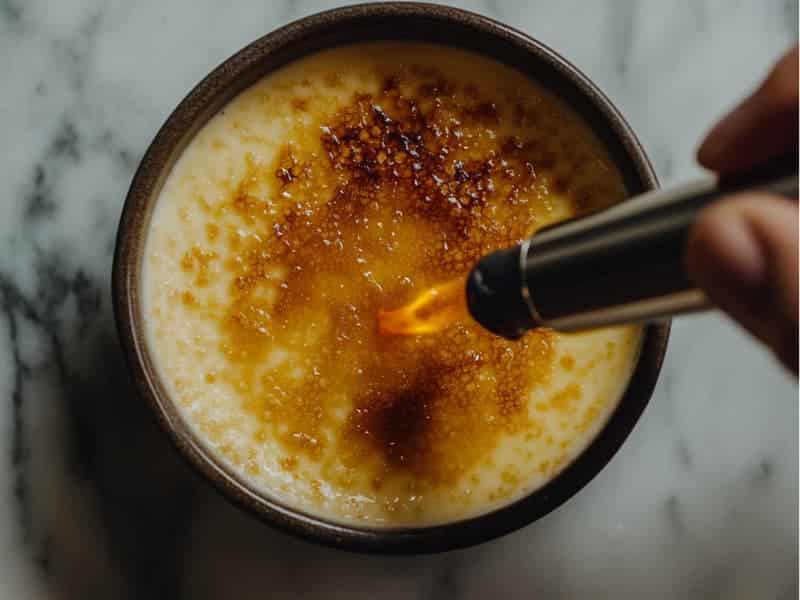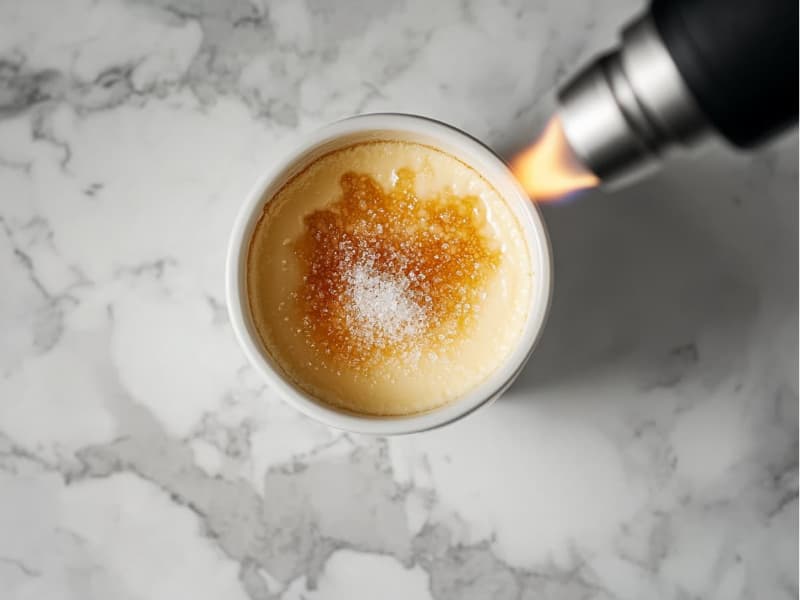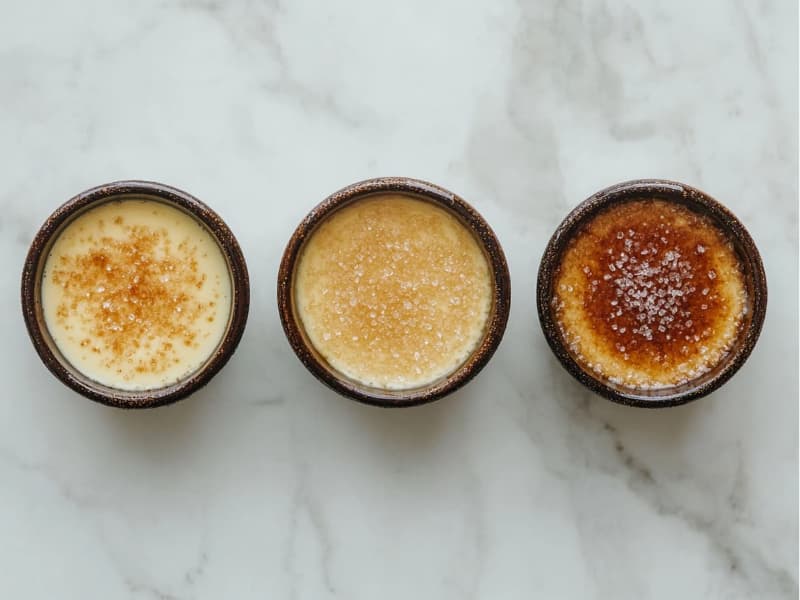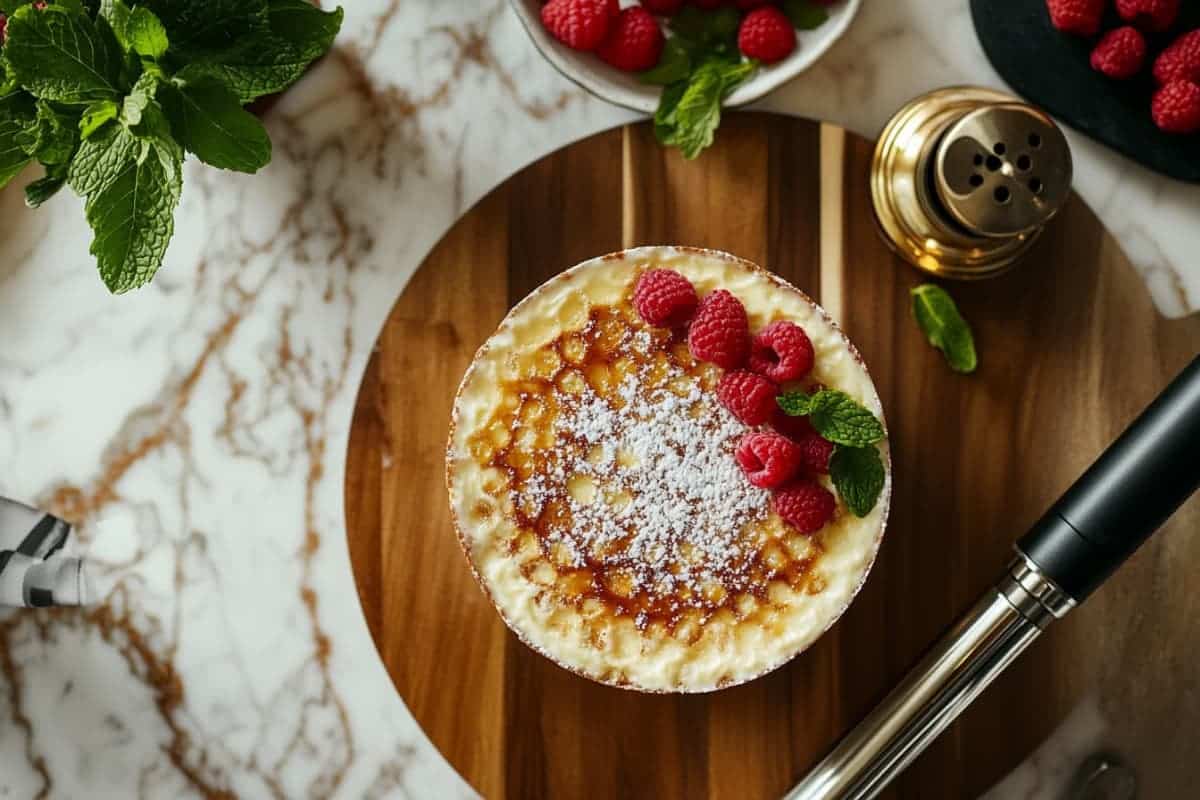Crème brûlée is a timeless dessert that combines velvety custard with a crisp, caramelized sugar topping. What sets this treat apart is the caramelized sugar layer that crowns it, adding both texture and flavor. Picking the right sugar is crucial to achieving the perfect balance. In this article, we’ll Innovate everything you need to know about selecting the best sugar for crème brûlée. From the desert’s rich history to the science of caramelization, we’ll dive into different sugar types, their unique flavors, and how they impact the final result. Whether you’re a seasoned chef or a home cook, this guide will help you master the art of creating the perfect crème brûlée.
Table of contents
Introduction to Crème Brûlée and Its Signature Caramelized Sugar Topping
The History and Popularity of Crème Brûlée
Crème brûlée, which translates to “burnt cream,” has a rich history that spans centuries. While its exact origins are debated, with both France and England claiming its creation, there’s no denying its global appeal. This dessert has graced the tables of royalty and become a staple in fine dining restaurants worldwide. Its simplicity—just cream, sugar, eggs, and vanilla—combined with its luxurious texture, makes it a favorite among dessert lovers.
The dessert’s popularity lies in its perfect balance of flavors and textures. The creamy custard base, often infused with vanilla or other subtle flavors, contrasts beautifully with the crisp, caramelized sugar topping. This combination creates a sensory experience that’s both comforting and indulgent.
The Role of Sugar in Achieving the Perfect Crème Brûlée
Sugar plays a starring role in crème brûlée, and it’s not just about sweetness. The caramelized sugar topping is what gives this dessert its signature crunch and visual appeal. When done right, the sugar forms a thin, glass-like layer that shatters with the tap of a spoon, revealing the smooth custard underneath.
But achieving that perfect topping isn’t as simple as sprinkling sugar and torching it. The type of sugar you use, the thickness of the layer, and the caramelization technique all play a part. Too much sugar, and the topping can become overly thick and chewy. Too little, and it might not provide that satisfying crack. The key is to find the right balance, which starts with choosing the best sugar for crème brûlée.
Why Choosing the Right Sugar Matters
Not all sugars are created equal when it comes to caramelizing. Some sugars melt too quickly, while others don’t caramelize evenly. The wrong choice can lead to a topping that’s either burnt or soggy, ruining the dessert’s delicate balance.
For instance, granulated sugar is a popular choice because it melts evenly and creates a smooth, crackly layer. On the other hand, brown sugar adds a rich, molasses-like flavor but can make the topping stickier due to its moisture content. Coarse sugars like turbinado or Demerara offer a unique texture and deeper flavor but require more care to caramelize evenly.
So, what is the best sugar to use on crème brûlée? The answer depends on your preferences and the experience you want to create. Whether you’re aiming for a classic, smooth topping or something with a bit more texture and flavor, understanding the characteristics of each sugar type is essential.
Exploring the Science of Caramelization
Caramelization is a fascinating process that transforms sugar into a golden, flavorful layer. When sugar is heated, its molecules break down and recombine, creating new compounds that give caramel its distinct taste and color. The temperature at which this happens is crucial—too low, and the sugar won’t caramelize; too high, and it will burn.
For crème brûlée, the goal is to achieve a golden-brown caramelization that’s evenly distributed across the surface. This requires patience and precision, as well as the right tools. A kitchen torch is the most common method, allowing for controlled heat application. Alternatively, a broiler can be used, though it’s less precise and requires careful monitoring.
Understanding the science behind caramelization can help you troubleshoot common issues, such as uneven browning or burnt spots. It also highlights why choosing the right sugar is so important—different sugars caramelize at different rates and temperatures, affecting the final result.
The Art of Presentation
Beyond flavor and texture, the caramelized sugar topping also plays a key role in the dessert’s presentation. A perfectly caramelized crème brûlée is a feast for the eyes, with its glossy, golden surface and delicate cracks. Garnishes like fresh berries, mint leaves, or edible flowers can raisethe presentation even further, making it a show-stopping finale to any meal.
Print
Best Sugar for Crème Brûlée
- Total Time: 15 minutes
- Yield: 4 servings
Description
Discover the secrets to choosing the best sugar for crème brûlée. Learn how different sugar types affect flavor, texture, and caramelization for the perfect crackly top.
Ingredients
- Granulated sugar
- Brown sugar
- Turbinado sugar
- Demerara sugar
- Powdered sugar
- Kitchen torch or broiler
Instructions
- Prepare your chilled crème brûlée custards.
- Sprinkle a thin, even layer of your chosen sugar on top of each custard.
- Hold a kitchen torch about 2–3 inches away and move in slow, circular motions.
- Caramelize the sugar until it turns golden brown and bubbly.
- Allow to cool for 1–2 minutes until a crisp layer forms.
- Serve immediately and enjoy the perfect balance of creamy and crunchy.
Notes
Granulated sugar gives the smoothest, most even caramelization. Turbinado or Demerara sugars offer deeper flavor and texture. Avoid too thick a layer to prevent chewiness.
- Prep Time: 10 minutes
- Cook Time: 5 minutes
- Category: Dessert
- Method: Caramelized
- Cuisine: French
What is the Best Sugar for Crème Brûlée?
Factors to Consider When Choosing Sugar for Crème Brûlée
When deciding what is the best sugar to use on crème brûlée, consider factors like flavor, texture, and ease of caramelization. The right sugar should melt evenly, create a crisp topping, and complement the custard’s richness.
Expert Recommendations for the Best Sugar Type
Most chefs agree that granulated sugar is the safest bet for beginners. It’s reliable, easy to work with, and delivers consistent results. For a more adventurous twist, turbinate or Demerara sugar can add unique flavors and textures.
Pros and Cons of Each Sugar Type
- Granulated Sugar: Pros—even caramelization, easy to find. Cons—basic flavor.
- Brown Sugar: Pros—rich flavor. Cons—stickier texture.
- Turbinate Sugar: Pros—natural, crunchy. Cons—uneven melting.
- Demerara Sugar: Pros—caramel flavor, texture. Cons—trickier to use.
- Powdered Sugar: Pros—fine texture. Cons—burns easily.
How to Caramelize Sugar on Crème Brûlée Like a Pro
Step-by-Step Guide to Caramelizing Sugar

Caramelizing sugar for crème brûlée might seem tricky, but with the right steps, it’s a breeze. First, sprinkle an even layer of your chosen sugar (the ideal type depends on your preference) over the custard. Next, use a kitchen torch to melt the sugar, moving it in slow, circular motions. Keep the flame about 2–3 inches away to avoid burning. Once the sugar turns golden brown and bubbles slightly, stop. Let it cool for a minute to harden into that perfect, crackly layer.
Tools You Need for Perfect Caramelization

To nail this process, you’ll need a few key tools. A kitchen torch is essential—it gives you control over the heat and includes even caramelization. If you don’t have one, you can use your oven’s broiler, though it’s less precise. A fine-mesh sieve can also help distribute the sugar evenly for a consistent topping.
Common Mistakes to Avoid When Caramelizing Sugar
One of the biggest mistakes is using too much sugar, which can lead to a thick, chewy layer instead of a crisp one. Another pitfall is holding the torch too close, causing the sugar to burn. Lastly, don’t rush the process—take your time to achieve that perfect golden hue.
Experimenting with Different Sugars: Flavor and Texture Comparisons
How Different Sugars Affect the Flavor of Crème Brûlée
The type of sugar you use can dramatically change the flavor of your crème brûlée. Granulated sugar keeps it classic, while brown sugar adds a rich, molasses-like depth. Turbinado and Demerara sugars introduce a subtle caramel note, making them great for those who enjoy a more complex taste.
Texture Differences Between Sugar Types
Texture is just as important as flavor. Granulated sugar creates a smooth, glass-like topping, while coarse sugars like turbinado and Demerara add a satisfying crunch. Brown sugar, on the other hand, can make the topping slightly sticky.
Creative Sugar Blends for Unique Crème Brûlée Variations

Why stick to one type of sugar? Mixing sugars can create unique flavor and texture profiles. For example, combining granulated sugar with a bit of Demerara can give you both smoothness and crunch. Experimenting with blends is a fun way to put your own spin on this classic dessert.
Delicious dessert recipes, check out our Ultimate Guide to Classic French Desserts.
FAQs
hat is the best sugar to caramelize?
The best sugar to caramelize for most desserts, including crème brûlée, is granulated sugar. It melts evenly and creates a smooth, crackly layer. For a richer flavor, turbinado or Demerara sugar are excellent alternatives, though they have a coarser texture.
What is the sugar on top of crème brûlée called?
The sugar on top of crème brûlée is called the caramelized sugar topping or simply the burnt sugar layer. It’s created by sprinkling sugar over the custard and using a kitchen torch or broiler to melt and caramelize it.
What sugar is best for crème brûlée Reddit?
According to Reddit discussions, granulated sugar is the most popular choice for crème brûlée due to its even caramelization. However, many users also recommend turbinado or Demerara sugar for a deeper flavor and slight crunch.
Is brown sugar good for crème brûlée?
Yes, brown sugar can be used for crème brûlée, but it has a higher moisture content, which can make the topping stickier rather than crisp. It adds a rich, molasses-like flavor, making it a great option for those who enjoy a deeper taste.
Conclusion: Finding Your Perfect Sugar for Crème Brûlée
When it comes to what is the best sugar to use on crème brûlée, there’s no one-size-fits-all answer. Granulated sugar is a reliable choice for beginners, while turbinado and Demerara sugars offer unique flavors and textures. Brown sugar can add richness, but it might not give you that classic crackle. Ultimately, the best sugar depends on your taste and the experience you want to create. Don’t be afraid to experiment with different types or even blends to find your perfect match. After all, making crème brûlée is as much about creativity as it is about tradition.
Tips on perfecting your desserts, check out our Guide to Mastering French Pastries. Happy cooking!

